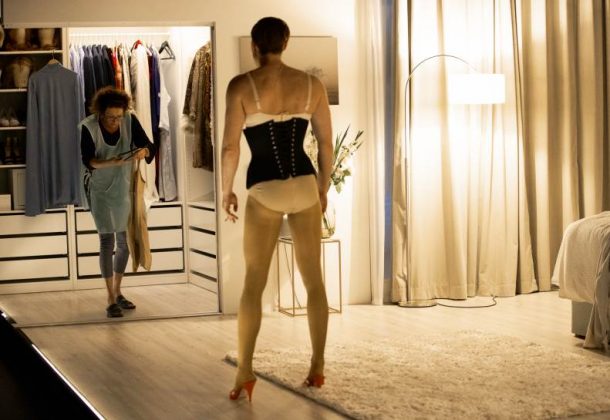Ophelia is in her room, sewing. Enter Hamlet. He takes her “by the wrist” and holds her “hard.” Really hard. Clearly it hurts. He shakes her. Then he extends his arm, leaning back to look, and “falls to such perusal of [her] face as he would draw it” (Hamlet 2.1). Finally, he stops, takes a cassette tape out of his pocket and inserts it hurriedly into a machine. He presses play, then begins to dance. He may be threatening. He may just be contorted in self-absorption. Ian Curtis sings:
When routine bites hard and ambitions are low,
When resentment rides high and emotions won’t grow
[…]
Then love, love will tear us apart again. (Joy Division “Love Will Tear Us Apart”)
This scene, from Ophelias Zimmer, Katie Mitchell’s 2016 adaptation of Hamlet for the Schaubühne Berlin (with Jenny König as Ophelia and Renato Schuch as Hamlet) replayed in my mind as I watched Mitchell’s new production of Jean Genet’s De Meiden (The Maids), for the Toneelgroep Amsterdam on tour at deSingel in Antwerp (the production opened on 11 December 2016 at the Stadsschouwburg Amsterdam). The ingredients were all there again. The abrupt entrance of a man into a private female space was repeated by Thomas Cammaert as a drag Madame. His hands, like Hamlet’s, violently controlled the movements of his female social inferiors. The preoccupation with gazing and being gazed upon was also repeated in the large, illuminated mirror that twice-captured Marieke Heebink’s Claire as she made herself up to play Madame. Likewise, the swapping of tabards between the sisters generated a peculiar mirroring that effectively allowed Claire to sneer at the version of herself represented by Chris Nietvelt’s Solange. Hamlet’s gyrating dance was included in this new production as well, recapitulated in a celebratory key as Cammaert’s Madame prepared to meet his/her lover who had been released on bail from prison. Although Joy Division’s music was absent from the soundtrack that instead took in film-score classical and techno, the obsessive attention in “Love Will Tear Us Apart” to the tipping-point between affection and violence, compulsion and repulsion, throbbed beneath Mitchell’s taut and outwardly clinical staging of Genet’s play.
There’s a taste in my mouth
As desperation takes hold
Just that something so good
Just don’t function no more
And love, love will tear us apart again.
Love
Chloe Lamford’s detailed, naturalistic set for De Meiden located the play in a contemporary bedroom. A hallway stage left and dressing room stage right framed the central area (though, this being a Katie Mitchell production, there was nothing “central” as such, and term should be taken to mean “sitting on the golden section”). The main space was dominated by a bed (upstage center), lit from stage right by a large, apparently east-facing window (an arrangement that recalled Mitchell’s 2014 Young Vic Cherry Orchard, in which Ranevskaya’s dead son’s bed occupied the same position relative to a large window). To the stage left side of the bed sat a dressing table equipped with a large, circular mirror. Since the windows were not opened (as Genet’s text suggests they should be), Claire and Solange did not look out to the street in anticipation of their mistress’s return as we might expect them to. With footsteps sounding from above, I had the impression of a high-level apartment, overlooking a prosperous European city. It conformed to the clichés of decadent minimalism, like a property advert designed to appeal to the urban élite. The white expanses of Lamford’s set thus functioned not only as a realistic representation of contemporary minimalist opulence but also as a mirror in which a bourgeois audience might see their aspirational desires reflected.
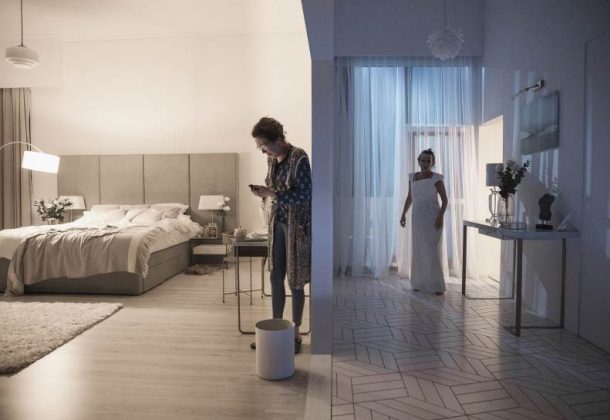
Katie Mitchell’s De Meiden. Photo: Jan Versweyveld.
The audience was not, however, merely invited to covet the play’s location. It also functioned as a visual metaphor for the insurmountable inequality that keeps Madame beyond the reach of her servants, here played as Polish immigrants. Mitchell’s decision to place this geopolitical gulf between the characters was characteristic of a production in which Solange and Claire were emphatically out of sync with the surroundings that they desired. Their mismatched leggings and tabard-cum-house-dresses visually jarred with the white apartment, and the frantic hurry of their preparations disrupted the long lines of its opulent minimalism. They were also both significantly older than Genet’s suggested thirty-five. The cruel fantasy of Claire-as-Madame’s suggestion that Solange-as-Claire might be pregnant by the milkman (who seems to have raped them both) was thus doubled by biological implausibility. In short, Nietvelt and Heebink’s Solange and Claire were geographically, spatially, and temporally displaced. This overwhelming sense of displacement (to which I will return), cast them as unrequited lovers, not only of their master-mistress, but also of the wealth and youth that they were paid to maintain.
These servants were not only displaced but also confined: Solange and Claire were trapped in the hard bite of their routinely recreated fantasies, and in the impossible attempt to leave no trace of their existence on the apartment’s gleaming décor. They detested and adored their surroundings in equal measure, and this contradictory impulse was mined in the gesture of Nietvelt’s Solange spitting on and then briskly polishing the mirror. Aiming her contempt at Madame, she hit her own reflection, which she obscured with her wiping hand, only to make it all the more clear. Such attempts to erase the traces of themselves resonated throughout Nietvelt and Heebink’s performances: Solange used her iPhone to take photographs as references for the rearrangement of dresses on a rail, and they obsessively cleaned and replaced the objects they had touched or used. They even skittered across the carpets as if afraid to upset the grain of their pile.
This production was, in other words, a drama of self-erasure played out with the props of acquisition. It gradually exposed the yearning for obliteration that lies coiled at the center of acquisitive desire. Indeed, it emphasised throughout that Genet’s maids love and hate alike: that their obsession with their mistress, born of inferiority, can only lead to self-disgust. “I want to help you,” Solange says to Claire, “I want to comfort you, but I know I disgust you. I’m repulsive to you. And I know it because you disgust me” (all quotations from the play are taken from the Faber & Faber edition of the play, translated by Bernard Frechtman). If Claire performs Madame impeccably (“I loathe servants. A vile and odious breed […] They’re not of the human race.”), then her success can only extend the gulf between that performance and the self she sees reflected in her sister’s performance of “Claire.” And if Claire fails in her parody (as, eventually, she must), then she reconfirms her inability to transcend barriers of age, class, and (in this production) nationality. This is the beauty contest’s double bind: any judgement is a condemnation.
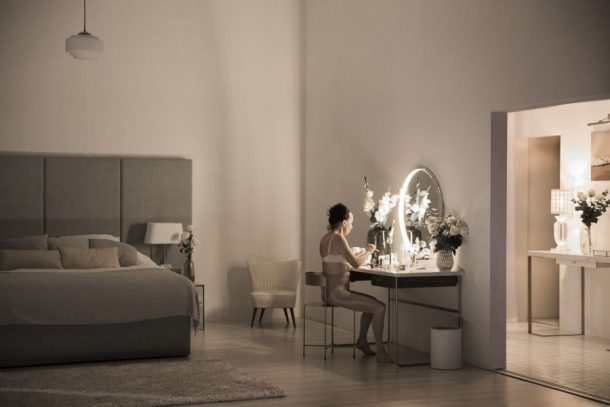
Katie Mitchell’s De Meiden. Photo: Jan Versweyveld.
Despite this destructive logic, the production was also characterized almost constantly by the unconscious intimacy of the sisters’ physical interactions. These unthinking gestures of care, and the detailed mutual understanding that they embodied, ensured that we heard Solange’s argument that “when slaves love one another, it’s not love” as an affirmation not of love’s absence, but of its failure to redeem them. Clearly, they loved each other, and, just as clearly, that love conspired in their destruction. Indeed, as Nietvelt’s Solange cradled her sister’s dying body on the central bed in the production’s final image, we watched as love tore them apart.
Tear
The maids’ gestures of care contrasted strongly with the behaviour of Cammaert’s Madame, whose physical presence dominated both Claire and Solange whenever s/he was present. Angered, s/he grabbed Heebink’s Claire by the upper arm so that she was fixed in position, looking up into her/his face. There was never any serious threat here of a “maids’ rebellion” creating a rupture in the social fabric of oppression. The absence of that possibility recalled Genet’s attempt, in reflecting on the activities of the Rote Armee Fraktion and their subsequent trial, to distinguish between violence (which might refer, positively, to “a bud bursting forth”) and brutality: “a brutal gesture […] halts and suppresses a free act” (“Violence and Brutality” in The Declared Enemy: Texts and Interviews, 171-2). Genet argued that the exclusions and oppressions that constitute brutality “are often not immediately discernible” as such, and he offered examples, mainly drawn from forms of social organization:
the architecture of public housing projects; bureaucracy; the substitution of a word – proper or familiar – by a number; the priority, in traffic, given to speed over the slow rhythm of the pedestrian; the authority of the machine over the man who serves it; the codification of laws that override custom; […] the useless slaps and blows in police stations; the condescending speech of police addressing anyone with brown skin; the obsequious bowing for the sake of a generous tip and the mockery and crudeness if there is none… (“Violence and Brutality” 172).
Mitchell’s maids were presented as victims of exactly such a brutal and brutalizing society. They were constantly signaled as others: a “them” against which privileged bourgeois society defines itself. And the brutality of that exclusion has been so effectively internalized and harnessed to oppression that its direct effects are almost invisible.
But the effects of brutality were sometimes discernible. Not only did the oppressive grip of Cammaert’s Madame subdue Claire, but Mitchell also revealed the indirect effects of her brutal existence in a small but crucial dramaturgical intervention. As Heebink’s Claire made up to play “Madame” near the start of the performance, she was overcome by uncontrollable coughing. She attempted to recover, holding a tissue to her mouth but continuing to cough. When the fit subsided, she removed the tissue to reveal a patch of blood that blotted the pristine white of Lamford’s set. The connotation was clear: Claire has a serious, possibly fatal disease. I assumed that the illness was intended to be lung cancer, connecting it indelibly to the play’s charades, in which smoking featured centrally as a performative signifier of “Madame.” The coughing and blood also suggested tuberculosis, a disease that thrived in the conditions experienced after industrialization by the urban poor. Claire’s fate was therefore connected not only with her performance of “Madame” but with brutal social inequality. But, whether it was read as a consequence of the maids’ fantasy or of their social vulnerability, the blood’s shocking reality punctured their performance, tearing a hole in its center.
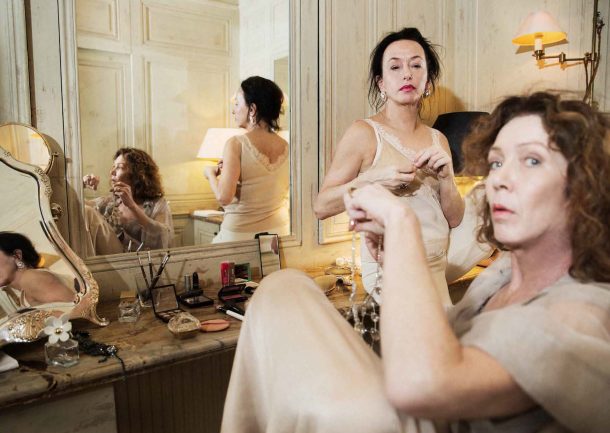
Katie Mitchell’s De Meiden. Photo: Jan Versweyveld.
As the performance continued, Heebink’s Claire was repeatedly torn apart by such coughing, and consequently depended upon her sister for care and support. She was also clearly marked for death. This had the effect of displacing Heebink’s Claire from herself. First, she gave up her clothing for Solange’s costume. Then she made herself up to play Madame. When coupled with her illness, this process converted her into a soon-to-be-corpse. Donato Wharton’s sound design amplified that effect with the buzzing of unseen flies, apparently breeding somewhere in the rotten fabric of the onstage world. Mitchell’s decision to foreshadow Claire’s death in this way might be considered to reduce assisted suicide a few degrees to euthanasia. But whether the condition from which Claire asks her sister to release her is existential despair or terminal illness is not, I think, particularly significant. If anything, Mitchell’s alteration to the text’s back-story suggested the extent to which social and psychological harm are written on – and in – our bodies. It also underlined their inescapability. Both psychologically and physiologically, Heebink’s Claire had already been racked before the play’s beginning, and before the end she would be torn apart.
Again
Thus, both love and violence were displaced in this production. Love was revealed in the caring manner of the sisters’ self-destructive interactions and violence was submerged beneath patterns of action designated as care. This pattern of displacement was most obvious in Mitchell’s decision, to which I have already alluded, to cast Thomas Cammaert as a drag Madame. There is a precedent for this choice in Genet’s suggestion that the maids might be played by adolescent men. But whereas Genet proposed that the characters would remain designated female, Thomas Cammaert’s Madame was unmistakably a man. His penis was visibly untucked and re-tucked as he changed clothes, so his sex was not in any doubt. His gender identity may have been intended to be read as female or gender-queer, but that possibility was never signposted. In all, the production suggested a transvestite more than a transgender conception of the role. Mitchell’s use of drag seemed to me to be profoundly un-queer. It worked much more to reinforce than to contest conventional gender categories and to reassert, rather than undermine, the patriarchal power that they scaffold.
It was tempting to read Mitchell’s drag-Madame, in part, as a critique of the popular phenomenon of drag in productions by other prominent European directors that do not engage more substantially in questions of gender and power. The ease with which male-identified people may adopt female clothing and appropriate female-designated roles, Mitchell seemed to suggest, often functions not to destabilize gender but to reassert patriarchy’s authority over representation. By claiming and reiterating conventional tropes of femininity in gesture, clothing, gait, and speech, Cammaert’s Madame worked to emphasise the inaccessibility of an acceptable, desirable female identity to his maids. Or rather, he held that identity just beyond their grasp. Jean-Paul Sartre wrote of the play that “the Master convinces the servant that there is no other way to be a man than to be a master [sic]” (published as the Introduction to the Faber & Faber edition). As Heebink’s Claire smoked and leaned seductively on one hip, aping her master’s appropriation of the postures of a femme fatale, it seemed that she had been convinced that there was no other way to be a woman than to be created by and for a man. To be recognizably female in this world, in other words, required Claire to sacrifice the right to be a woman.
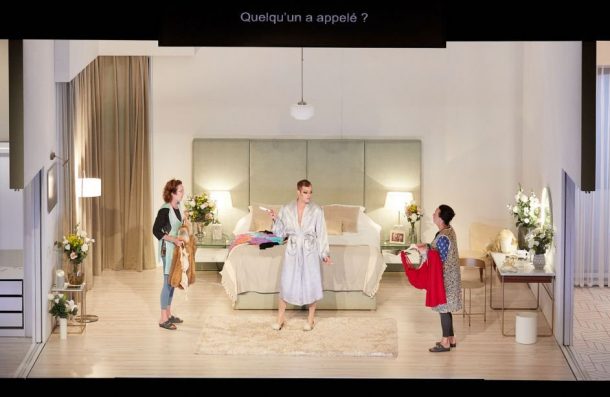
Katie Mitchell’s De Meiden. Photo: Jan Versweyveld.
The key to that paradox, of course, is recognizability. And the key to recognition is repetition. Mitchell’s production traded in repetitive patterns. The maids’ scenes were twice set up identically, like shots, with repositioned domestic lighting, household objects (such as a sheathed kitchen knife) treated like props, and the soundtrack provided by an iPad. They also consisted of poses that were generically recognizable from cinema (the knife, for example, clearly referencing Psycho). Later, the fatal dose of tea was delivered to Claire by Solange in a staging that repeated Claire’s failed attempt to give it to her mistress. Of course, if actions are repeated in this way, and themselves repeat the reiterated patterns of a dominant culture, then they are functionally inescapable. This was a production whose conclusion was always already happening. As the maids began their ritual, Nietvelt’s Solange used her phone to take photographs of the apartment in order to return it, once again, to its unblemished state. The photographs also made the apartment already a crime scene. Likewise, Claire’s repeated attacks of coughing asserted that she was already dying, and the bed, already surrounded by flowers, was always prepared for her death.
Lying on this bed, and cradling her dying sister, Nietvelt’s Solange attempted to sublimate her death into an image of imminent resurrection for them both and all their fellow maids. Her attempt was given some support by the dawn light from the stage right window. It suggested the glow or glare of publicity that might attach itself to this event, as it did to the case of Christine and Léa Papin. Their discovery, also in bed together, having murdered their mistress and her child was the event that gave rise to Genet’s play. But Mitchell’s closing image cut both ways. The sun rises, after all, again and again. And so we watched an event both sensational and deeply ordinary: they were torn apart…again.
Compulsive Realism
Reflecting on this production’s harnessing of the sensational and the ordinary recalls another work of art created in Holland and viewed in Belgium. In 1938, W.H. Auden famously encountered the painting “Landscape with the Fall of Icarus” (then attributed to Pieter Breughel the Elder) in a Brussels museum. He wrote, in his poem, “Musée des Beaux Arts,” with regard to suffering, that “the old masters […] understood / Its human position: how it takes place/ While someone is eating, or opening a window, or just walking dully along.” Of all contemporary European directors, Katie Mitchell sees this most acutely. She has returned time and again to the conventions of naturalism: to the eating and drinking, the opening and closing of windows and doors, and the “walking dully along” that undergird narratives of human suffering.
But while reiterating these aesthetic conventions, Mitchell has also attempted to break them open. And she has done so in remarkably painterly ways. In this production, as in so much of her work, the fourth wall was resolutely closed. The stage was, like so many paintings, a world unto itself. The staging also conformed, as Mitchell invariably does, to the proportions of the golden section. This lends her productions a curious quality of static dynamism. The lack of symmetrical balance makes her staging visually dynamic, yet the constant attention to proportional relations between scenographic elements gives it a somewhat schematic quality, with each successive moment constituting a static image. Mitchell also intervened here, as she has many times before, into the temporal frame of the action, slowing certain moments to capture gesture, posture, and spatial relationships in an almost painterly gaze. In the last thirteen years, Mitchell has also become known for the live, onstage creation of films. In doing so, she has taken much further her abstraction of highly constructed images from action that is governed by the nuts-and-bolts logic of realism. In the case of these productions, though, the scaffolding is not so much realist as real: cameras and lights must be placed and replaced exactly, marks must be hit, and sound must be exactly in sync with the action.
In Mitchell’s Fräulein Julie, she used the live film to break apart the class-bound, gendered structures of Strindberg’s play and expose the plight of the maid, Kristin, hidden in plain sight at its center. It was therefore impossible not to see Genet’s maids, in part, as bedroom-Mitchells, creating their own live film to expose the oppressive structures of their existence. But Claire and Solange’s failure to escape those structures reflected uncomfortably back on Mitchell’s directorial project. Are her repeated returns to canonical works similarly compulsive, returning her again and again to the sites of patriarchal and class power that she cannot ever finally overturn? What is more, does her adherence to the methodological and aesthetic diktats of realism compel her to naturalize and reassert – and therefore tacitly to endorse – the power structures that she sets out to critique? In The Maids, and frequently in Mitchell’s work, the only means of escape from these structures for women are found in self-harm and self-erasure. Has Mitchell, like Claire and Solange, become compelled repeatedly to re-enact those wounds? Clearly, she loves her work. But will it tear her apart, again?
Tom Cornford is Lecturer in Theatre & Performance at the Royal Central School of Speech and Drama, University of London and also works as a director and dramaturg. He is the author of articles about the histories and practices of acting and directing for journals including New Theatre Quarterly, Shakespeare Bulletin, Shakespeare Studies, and Theatre, Dance and Performance Training, as well as contributions to edited collections. Forthcoming projects include a long essay co-authored with Roberta Barker on the director Tyrone Guthrie for Bloomsbury’s Great European Theatre Directors series; a special issue of the journal Contemporary Theatre Review, co-edited with Caridad Svich, on the director Katie Mitchell, as well as two book projects, a monograph: Theatre Studios: Historicizing Ensemble Theatre-Making (Routledge, 2018) and an edited collection: Michael Chekhov in the Twenty-First Century: New Pathways, with Cass Fleming (Bloomsbury, 2018). Tom was the winner, in 2017, of the David Bradby Award for Early Career Research in European Theatre and serves on the editorial board of the journal Studies in Theatre and Performance.
European Stages, vol. 10, no. 1 (Fall 2017)
Editorial Board:
Marvin Carlson, Senior Editor, Founder
Krystyna Illakowicz, Co-Editor
Dominika Laster, Co-Editor
Kalina Stefanova, Co-Editor
Editorial Staff:
Taylor Culbert, Managing Editor
Nick Benacerraf, Editorial Assistant
Advisory Board:
Joshua Abrams
Christopher Balme
Maria Delgado
Allen Kuharsky
Bryce Lease
Jennifer Parker-Starbuck
Magda Romańska
Laurence Senelick
Daniele Vianello
Phyllis Zatlin
Table of Contents:
- The 2017 Avignon Festival: July 6 – 26, Witnessing Loss, Displacement, and Tears by Philippa Wehle
- A Reminder About Catharsis: Oedipus Rex by Rimas Tuminas, A Co-Production of the Vakhtangov Theatre and the National Theatre of Greece by Dmitry Trubochkin
- The Kunstenfestivaldesarts 2017 in Brussels by Manuel Garcia Martinez
- A Female Psychodrama as Kitchen Sink Drama: Long Live Regina! in Budapest by Gabriella Schuller
- Madrid’s Theatre Takes Inspiration from the Greeks by Maria Delgado
- A (Self)Ironic Portrait of the Artist as a Present-Day Man by Maria Zărnescu
- Throw The Baby Away With the Bath Water?: Lila, The Child Monster of The B*easts by Shastri Akella
- Report from Switzerland by Marvin Carlson
- A Cruel Theatricality: An Essay on Kjersti Horn’s Staging of the Kaos er Nabo Til Gud (Chaos is the Neighbour of God) by Eylem Ejder
- Szabolcs Hajdu & the Theatre of Midlife Crisis: Self-Ironic Auto-Bio Aesthetics on Hungarian Stages by Herczog Noémi
- Love Will Tear Us Apart (Again): Katie Mitchell Directs Genet’s Maids by Tom Cornford
- 24th Edition of Sibiu International Theatre Festival: Spectacular and Memorable by Emiliya Ilieva
- Almagro International Theatre Festival: Blending the Local, the National and the International by Maria Delgado
- Jess Thom’s Not I & the Accessibility of Silence by Zoe Rose Kriegler-Wenk
- Theatertreffen 2017: Days of Loops and Fog by Lily Kelting
- War Remembered Onstage at Reims Stages Europe: Festival Report by Dominic Glynn
Martin E. Segal Theatre Center:
Frank Hentschker, Executive Director
Marvin Carlson, Director of Publications
Rebecca Sheahan, Managing Director
©2016 by Martin E. Segal Theatre Center
The Graduate Center CUNY Graduate Center
365 Fifth Avenue
New York NY 10016
